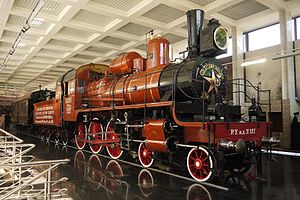Russian locomotive class U
| Russian locomotive class У [U] | |||||||||||||||||||||||||||||||||||||||
|---|---|---|---|---|---|---|---|---|---|---|---|---|---|---|---|---|---|---|---|---|---|---|---|---|---|---|---|---|---|---|---|---|---|---|---|---|---|---|---|

Russian locomotive class U, number 127 (preserved)
|
|||||||||||||||||||||||||||||||||||||||
|
|||||||||||||||||||||||||||||||||||||||
|
|||||||||||||||||||||||||||||||||||||||
|
|||||||||||||||||||||||||||||||||||||||
|
|||||||||||||||||||||||||||||||||||||||
| Type and origin | |
|---|---|
| Power type | Steam |
| Builder | Putilov factory |
| Build date | 1906–1912 |
| Total produced | 62 |
| Specifications | |
|---|---|
| Configuration: |
|
| • Whyte | 4-6-0 |
| • UIC | 2'C n4v |
| Gauge | 1,524 mm (5 ft) |
| Leading dia. | 950 mm (3 ft 1 3⁄8 in) |
| Driver dia. | 1,730 mm (5 ft 8 1⁄8 in) |
| Length |
|
| Height | 5,080 mm (16 ft 8 in) |
| Axle load | 15.2 tonnes (15.0 long tons; 16.8 short tons) |
| Adhesive weight |
|
| Loco weight |
|
| Fuel type | Fuel oil or coal |
| Firebox: • Firegrate area |
2.72 m2 (29.3 sq ft) |
| Boiler pressure | 14.0 kg/cm2 (1.37 MPa; 199 psi) |
| Heating surface |
|
| Cylinders | Four, compound |
| High-pressure cylinder |
|
| Low-pressure cylinder | 580 mm × 650 mm (22 13⁄16 in × 25 9⁄16 in) |
| Performance figures | |
|---|---|
| Maximum speed | 115 km/h (71 mph) |
| Career | |
|---|---|
| Disposition | U-127 only at the Museum of the Moscow Railway |
The Russian locomotive class U (Russian: У) was a Russian express passenger steam locomotive type. The class U was a 4-6-0 four-cylinder compound locomotive which used de Glehn compound system.
One unit, Locomotive U-127 was preserved as part of a memorial to Vladimir Lenin, at the Museum of the Moscow Railway
Steam locomotives with the wheel arrangement 4-6-0 were widely used on the Russian railways in the late 19th and early 20th century. A rigid base formed by three driving axles ensured a smooth ride on straight tracks without much sideways movement, and а two-axial steering bogie meant good performance on curve tracks. 4-6-0 locomotives of most popular Russian class А were being used among others on the Ryazan-Urals Railway and covered Russia’s passenger transportation needs until 1901, when the necessity to build a more powerful locomotive class emerged.
A weak track structure with a light load carrying capacity limited the axle load. Operational experience with two-cylinder engines showed that they had a poor starting ability, accelerated comparatively slowly and had a rough ride. So the Head of the Ryazan-Ural Railway Hauling Service engineer A.E. Delacroix decided to use a technical design specification for a locomotive of type 4-6-0 equipped with a four compounding cylinders.
In July 1903 the Engineering Board of the Ministry of Communications approved a new locomotive design elaborated at the Putilov factory (later Kirov Plant) in Saint Petersburg under the supervision of the engineer M.V. Gololobov. The design included de Glehn compound system, which at that time was used on certain types of express passenger locomotives in Europe. In that system, high-pressure cylinders were mounted outside the frame and were connected with the second driving axle, while low-pressure cylinders were connected with the crank axle of the first driving axle. The firebox was designed for the use of oil as fuel and it had a small firedoor hole. There was no steam superheater.
At the end of 1906 the first locomotive of this type was built at the Putilov factory. After being tested in March 1907 it was sent to the Ryazan-Ural railway, where it was classified as P1 (Russian: П1).
...
Wikipedia
